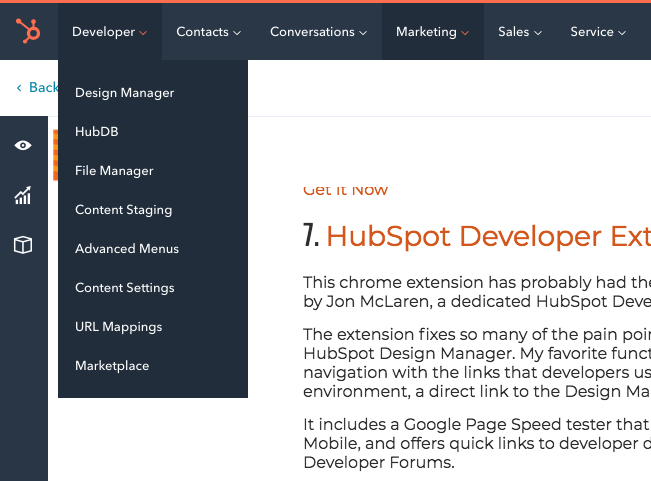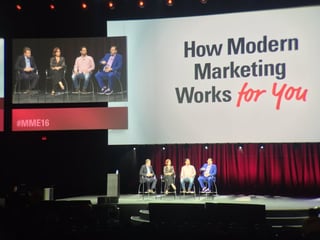
In case you hadn’t noticed, technology has blurred the lines between marketing and advertising.
The majority of enterprise brands in existence today have come to age during an era where media buys traditional advertising channels and superior creativity is represented highly by the dominant forces that captured market share and grew revenue.
However, in the last decade this traditional advertising mindset has taken a back seat to data-supported marketing initiatives.
I can remember early on in my own career, data-supported marketing was a new buzzword that baffled some of my former co-workers and bosses. These folks had always made decisions with limited information and a lot of gut instinct.
But in this new era, if your marketing isn’t supported by data, it may no longer be considered marketing.
The Era of Marketising
One of the benefits of speaking at large conferences is getting to hear what is actually on the minds and agendas of today's marketing thought leaders. I was recently able to catch one such panel discussion while on a trip to present at Oracle Marketing Cloud's Modern Marketing Experience in Las Vegas.
The panel, assembled by my friend and best-selling author Jay Baer, dared to define the convergence of marketing and advertising as a result of technology as Marketising. It was comprised of three of today’s most successful players across both disciplines:
- AdWeek's Editorial Director James Cooper
- Analyst and Author Rebecca Lieb
- Abercrombie & Fitch's Vice President of Omnichannel Marketing Andy Kennemer
The half hour discussion was incredibly thought provoking, and so I’ll do my best to capture the essence of the discussion here. The panelists shared some great soundbites throughout, and I have click to tweets at the very end with some of my favorites.
You can view the panel in it’s entirety by watching the archive of BrightCove's live stream here. The panel begins around the 58 minute mark in the General Session's Day Two video.
And away we go...
Give your audience the courage and know how to change their marketing for good.
{ Ask Nate Riggs to Keynote your Next Event }
The Beginning of the End
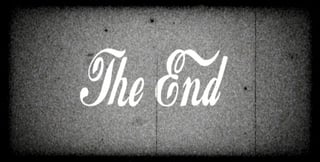 “It’s the beginning of the end of interruptive advertising as we know it” says Andy Cooper from AdWeek in response to Jay’s first question.
“It’s the beginning of the end of interruptive advertising as we know it” says Andy Cooper from AdWeek in response to Jay’s first question.
Cooper goes on to site supporting statistics related to time-shifting and ad blocking software that support his indication that marketing avoidance is a trend growing at an alarming rate.
Cooper points to the concept of data-enhanced brand storytelling as the future, but also believes that the data science behind it has a long way to go before we as marketers will achieve true one-to-one marketing.
“What’s unique about being in digital is that you never quite reach the finish line" says Andy Kennemer from Abercrombie as follow up to Cooper's comments.
Abercrombie & Fitch, an Oracle Marketing Cloud customer using Responsys to manage and execute their massive and incredibly complex email-marketing program, is in the midst of shifting to a data-driven practice that will meet the customer at the center of everything from outreach to the in-store experience.
“We definitely have a long way to go, and I think part of this comes back to how do you make your data actionable across not just one channel but multiple channels and multiple touch points.” says Kennemer.
He goes on to share that the biggest challenge for Abercrombie is managing the high amount of complexity on the back end of their marketing and advertising technology stack. “Despite what these tools can do for you, one system’s definition of a customer ID is different than the next, so you still have to really work to try and cross reference these disparate systems."
Another challenge for Andy and Abercrombie lies in stretching human expertise.
“We’ve got a team that really knows this stuff well, but they’re maxed out. They don’t have a lot of extra bandwidth, so when we want to extend into another channel, how do you give them the bandwidth to do more with less time? That’s a real obstacle we all deal with” says Kennemer.
Just in Time for The Holy Grail
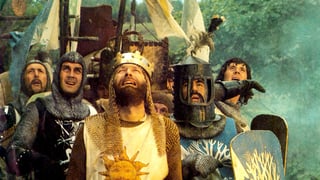 As big brand advertising diminishes, hyper relevant and just-in-time communications may provide the proverbial Holy Grail for marketers.
As big brand advertising diminishes, hyper relevant and just-in-time communications may provide the proverbial Holy Grail for marketers.
“Hyper relevant is becoming ever more specific” says Lieb. “So we’ve long heard about this Holy Grail being the right message to the right person at the right time. Now the right message to the right person at the right time also has to come in the right place, and in the right context.”
Lieb goes on to site the proliferation of smart mobile devices and tablets, but also beacons and sensors that are bringing the concept of the Internet of Things to life.
“Content is in the air” says Lieb. “The exchanges of information and also the exchanges of value between consumers and marketers are going to expand and multiply geometrically”.
Who’s the Boss?
 According toLieb, it’s no longer advertising.
According toLieb, it’s no longer advertising.
“You no longer have to make that value exchange whereby I will interrupt my viewing of this TV program to listen to this sponsored message. That’s now entirely optional, and consumers are leveraging their new authority here. And what that means is that advertising has traditionally been the boss because it’s been the most expensive form of marketing. But with content and with social, marketers can now test their advertising,” says Lieb.
“Why would you invest in a media buy before testing the content and creative on different audiences and segments, and really making sure it's the right message before you pour all those media dollars into it." Lieb goes on to suggest that advertising today has shifted from being the first thing that marketers do, to being the last thing that marketers will invest in.
Your Big FOMOSO
You along with many Modern Marketing Experience attendees have probably heard of FOMO, representing Fear of Missing Out. During the panel, the slight, albeit sarcastic variation of this FOMOSO or Fear of Missing Out on Software Opportunities was proposed during a question directed to Andy Kennemer.
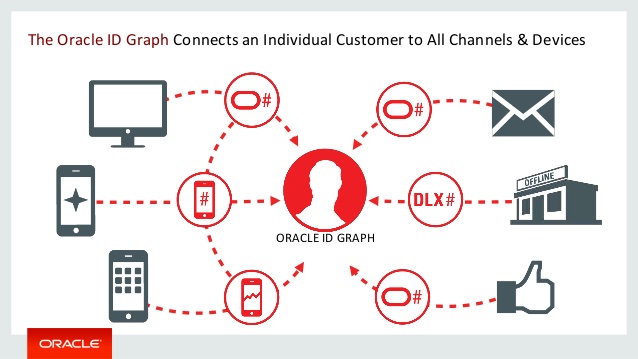 In the context of the discussion, many brands are bombarded by technology vendors on a daily basis, and it presents a sometimes overwhelming situation.
In the context of the discussion, many brands are bombarded by technology vendors on a daily basis, and it presents a sometimes overwhelming situation.
On one hand, brands experimenting with the latest and greatest technology can provide a first-mover's advantage in a highly competitive space. On the other hand, simply following the latest sparkling object can often result in wasted time, budget and resources.
Jay goes on to ask Andy how he and his team at Abercrombie have managed to attack various different aspects of the Oracle Marketing Cloud echo system, one thing at a time, while resisting the urge to boil the ocean and explore everything at once.
"It does take some patience and a very strong focus" says Kennemer. "We have a great team that knows how to set the vision and drive the agenda with our Oracle partners. We start with some basic triggers - the kind of thing most retailers can do pretty easily like abandon cart emails. We get those right and then start to iterate in a way that allow us to make it a more special experience for the consumer."
Kennemer suggests that staying focused on small iterations like this is the key to developing a larger, more integrated program where you can begin to bolt on new channels that become extensions of the customer ID graph.
"If somebody is not opening their email, how can I push a banner ad or send them a text message? How can I give them a push notification? That's where we're going next." says Kennemer.
Has Your Agency Fallen in the Gap?
 "I think that brands like Andy's that have great stories to tell have to step a bit more boldly into owning their data and creative and programmatic destiny. In terms of their relationships with agencies, they have to really push them to surface their consultancy muscle much more agressively" says Cooper in response to a question from Jay as to where third party service providers fit into the mix as marketing and advertising continue to converge.
"I think that brands like Andy's that have great stories to tell have to step a bit more boldly into owning their data and creative and programmatic destiny. In terms of their relationships with agencies, they have to really push them to surface their consultancy muscle much more agressively" says Cooper in response to a question from Jay as to where third party service providers fit into the mix as marketing and advertising continue to converge.
Jim believes that agencies have to avoid being distracted by advertising and marketing technology, and they should be trying to invest resources to hone their capabilities in management consulting.
"The gap that we see is that we've got vendors in this space that know the tools very well, but they don't know how to marry that with our strategy." says Kennmer in response. "It's up to the brand to align all parties around the table and make sure they play nice together" adds Lieb.
This moment during the panel held so much truth for me personally. I've been in the marketing agency business for the large majority of my career and have seen it play out both ways. From my own experience with clients, the most successful programs indeed tend to include both sides, but I liken this more to understanding each organization's separate culture and communication styles, and ensuring they are aligned before ever starting a business relationship.
In my mind, the real question is this -- is it the client or the agency that takes responsibility for determining if the relationship assures the right culture fit?
The Atomic Partical of Marketing
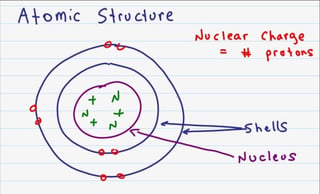 When the discussion turns to Lieb, she shares a statement that is set to become the title of her forthcoming book to be released in 2017, and was likely to be one of the most retweeted sound bites of the entire Modern Marketing Experience conference.
When the discussion turns to Lieb, she shares a statement that is set to become the title of her forthcoming book to be released in 2017, and was likely to be one of the most retweeted sound bites of the entire Modern Marketing Experience conference.
"Content is the atomic particle of all marketing", says Lieb. "There is no marketing without content. Facebook, Instagram and SnapChat would be empty vessels without content, and so too would advertising". (Click to Tweet Rebecca Lieb)
Lieb believes strongly that content strategy, now more than ever is essential.
The Next TV
 Video is more popular than ever, but video has also declined on television.
Video is more popular than ever, but video has also declined on television.
Baer goes on to ask Cooper his opinion on where the next big video channel will emerge.
"In the short term, it will be Facebook. Facebook has just barley dipped their toe in the video well, but once they go full in, they'll have a huge impact on the ecosystem."
Tweet the Final Round
Approximately 4500 attendees made their way to Las Vegas for Oracle's Modern Marketing Experience in 2016.
The audience represented a mix of customers, prospects, press and analysts, as well as a team of veteran social media influencers, or folks who have amassed large followings on popular social networks and their email subscriber database. I absolutely give kudos to Oracle's Chris Moody for driving a brave and innovative marketing vision for this global legacy software brand and including me in the plan.
"There are a lot of people here with a thirst for knowledge who are living this marketising scenario day to day. What's one tip would you give them as they work to take the next step on this journey?" says Baer positioning the final question for the panel.
"Make sure that your organizations are unicorn in nature. That means basically that you lean heavily into developing rigorous science behind your products, but also don't loose site of your creative destiny" states Cooper. (Click to tweet Jim Cooper)
"Strategy before tactics" says Lieb. "SnapChat is great. SnapChat crystallizes attention like maybe nothing prior to SnapChat, but don't jump on SnapChat because all the cool kids are doing it. Have a reason. Have a goal and have KPI's. This applies to not just SnapChat of course, but to all the new bells, whistles, toys and platforms out there. Don't jump on trends. Know what you are doing." (Click to tweet Rebecca Lieb)
In what may have been the most appropriate soundbite to wrap up the panel, Andy Kennemer follows up with "Focus less on what product you should be selling, and focus more on what customer need you are fulfilling." (Click to tweet Andy Kennemer)
Photo Credit for the panel image goes to Lee Oden of TopRank Marketing. Head over to the TopRank Marketing Blog for some excellent content.

-1.png)
